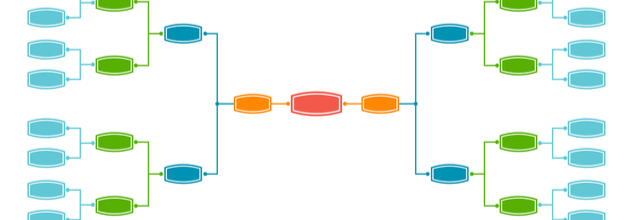Top News  Shutterstock Which sectors will make it to the Final Four? That's a question investors are asking as the new month kicks off after things turned south for stocks at the end of February. The biggest monthly rise in bond yields since 2016 injected fresh uncertainty into the market, bruising technology stocks and triggering volatility streaks that saw the DJIA swing more than 1,000 points over three days. Things appear to be turning around this morning as the 10-year Treasury yield fell 4 bps to 1.4%. Futures: Dow +1%; S&P 500 +1.1%; Nasdaq +1.5%.
Quote: "This week is key. I'm expecting turbulence or volatility to remain with us until we have a better understanding of where central banks stand," said Andrea Carzana, a fund manager at Columbia Threadneedle Investments. "Further consolidation is likely in March, but we expect the market to find support shortly and subsequently challenge the recent highs again," added Jeff Hirsch, editor of the Stock Trader's Almanac, noting that April is statistically the best month of the year.
Another area that is taking bets is a potential increase in inflation due to recent stimulus efforts. The House passed President Biden's $1.9T coronavirus relief bill on Saturday, while the Senate is expected to follow suit shortly. The package includes funding for vaccines and medical supplies, an extension of unemployment benefits, a round of $1,400 stimulus checks to individuals, and financial aid to small businesses and state and local governments. As a result, the U.S. Treasury is expected to sell a huge amount of debt in coming months to pay for the measure aimed at supporting the recovery.
Go deeper: Fed Chair Jay Powell has aligned with the administration in waving off concerns about an over-heated economy, saying the job market has ways to go before inflation fears are justified. The support could trigger a strong period of growth, low unemployment and rising wages, though critics argue that it may lead to a cycle of rising prices, higher interest rates and a ballooning national debt. The views don't only have investors sizing up March, but also who will be in the championship at the end 2021.    | | Top News  Shutterstock Which sectors will make it to the Final Four? That's a question investors are asking as the new month kicks off after things turned south for stocks at the end of February. The biggest monthly rise in bond yields since 2016 injected fresh uncertainty into the market, bruising technology stocks and triggering volatility streaks that saw the DJIA swing more than 1,000 points over three days. Things appear to be turning around this morning as the 10-year Treasury yield fell 4 bps to 1.4%. Futures: Dow +1%; S&P 500 +1.1%; Nasdaq +1.5%.
Quote: "This week is key. I'm expecting turbulence or volatility to remain with us until we have a better understanding of where central banks stand," said Andrea Carzana, a fund manager at Columbia Threadneedle Investments. "Further consolidation is likely in March, but we expect the market to find support shortly and subsequently challenge the recent highs again," added Jeff Hirsch, editor of the Stock Trader's Almanac, noting that April is statistically the best month of the year.
Another area that is taking bets is a potential increase in inflation due to recent stimulus efforts. The House passed President Biden's $1.9T coronavirus relief bill on Saturday, while the Senate is expected to follow suit shortly. The package includes funding for vaccines and medical supplies, an extension of unemployment benefits, a round of $1,400 stimulus checks to individuals, and financial aid to small businesses and state and local governments. As a result, the U.S. Treasury is expected to sell a huge amount of debt in coming months to pay for the measure aimed at supporting the recovery.
Go deeper: Fed Chair Jay Powell has aligned with the administration in waving off concerns about an over-heated economy, saying the job market has ways to go before inflation fears are justified. The support could trigger a strong period of growth, low unemployment and rising wages, though critics argue that it may lead to a cycle of rising prices, higher interest rates and a ballooning national debt. The views don't only have investors sizing up March, but also who will be in the championship at the end 2021.    | |
| Covid Traders today are also applauding the FDA approval of Johnson & Johnson's (JNJ) COVID-19 shot, which was the third jab to be approved in the U.S. It's the first to have a single-dose regimen, a key tool in accelerating the vaccination drive. The decision clears the way for immediate distribution and vaccination of the Janssen vaccine to Americans 18 and older, building on a broader rolloiut that's currently utilizing jabs from Pfizer/BioNTech (PFE, BNTX) and Moderna (MRNA).
Bigger picture: Shipments from J&J will be limited at first, with just a few million vaccines going out immediately, but the company has a deal to supply 100M doses by the end of June. The single-shot product had an overall efficacy rate of about 66% in the Phase 3 clinical trial, and the U.S. arm of the trial showed an efficacy rate of about 72% and of 85% when protecting against severe or critical disease. The lower efficacy rate compared than rivals is raising concerns that some people may opt to wait for other vaccines, but shares of JNJ are still up 3.5% premarket to $164.
"Be careful when you try to parse this percent versus that," Dr. Anthony Fauci told NBC's Meet The Press. "They were not compared head-to-head. They were compared under different circumstances. All three of them are really quite good and people should take the one that's most available to them."
Outlook: As of Sunday night, 49.8M people across the U.S. (15% of the population) had received their first coronavirus vaccine, while 24.8M people (7.5% of the population) had received two doses, according to the CDC. J&J has said it plans to ship the vaccine, which contains five doses per vial, at 36 to 46 degrees Fahrenheit. That compares to the ultra-cold freezers that are needed for Pfizer's vaccine - between minus 112 and minus 76 degrees Fahrenheit - as well as Moderna's vaccine, which needs to be shipped at 13 below to 5 degrees above zero Fahrenheit. (111 comments) |
|
|---|
|
|
|







EmoticonEmoticon